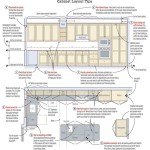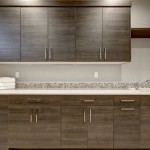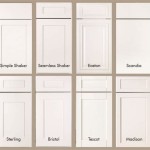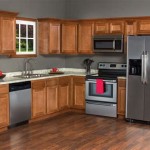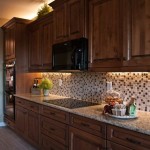Refinishing Melamine Kitchen Cabinets: A Comprehensive Guide
Melamine kitchen cabinets are a common and cost-effective choice for many homeowners. This is largely due to their durability, ease of cleaning, and affordable price point. However, melamine, a type of laminate made by heat-sealing a paper overlay onto a substrate (usually particleboard or MDF), can become dated or damaged over time. While replacing cabinets is an option, refinishing presents a more economical and environmentally conscious alternative. Refinishing melamine cabinets requires careful preparation and the use of appropriate materials to ensure a lasting and aesthetically pleasing result.
Refinishing melamine cabinets is not the same as refinishing solid wood cabinets. The smooth, non-porous surface of melamine prevents paint from adhering correctly without proper preparation. This article provides a detailed guide to refinishing melamine kitchen cabinets, covering key considerations and essential steps for a successful project.
Key Point 1: Assessing the Condition of Melamine Cabinets
Before embarking on the refinishing process, it is crucial to thoroughly assess the condition of the melamine cabinets. This evaluation will determine the scope of the project and the necessary repair work. Examine the cabinets for the following:
Delamination: Check for areas where the melamine laminate is peeling away from the substrate. Delamination is a common issue, especially around edges and near sources of heat or moisture. Minor delamination may be repairable, but extensive damage might warrant replacing the affected cabinet doors or panels.
Chipping and Cracks: Inspect the edges and surfaces for chips and cracks. Small imperfections can be filled, while larger cracks may require more extensive repairs.
Water Damage: Look for signs of water damage, such as swelling, discoloration, or mold growth. Water damage can severely compromise the structural integrity of the cabinets and may necessitate replacement.
Stains and Scratches: Evaluate the severity of existing stains and scratches. Minor surface imperfections can typically be addressed with proper cleaning and priming. Deeper scratches may require filling and sanding.
Hardware Condition: Assess the condition of the cabinet hardware, including hinges, handles, and knobs. Consider replacing outdated or damaged hardware to complement the newly refinished cabinets. Make sure to measure the existing hardware hole spacing to ensure compatibility with new selections.
Once the assessment is complete, document any areas requiring repair. This will help to streamline the preparation process and ensure that all necessary materials are readily available.
Key Point 2: Necessary Materials and Tools
Refinishing melamine cabinets requires a specific set of materials and tools to achieve a professional finish. Gather the following items before starting the project:
Cleaning Supplies: A degreasing cleaner, such as trisodium phosphate (TSP) or a TSP substitute, is essential for removing grease, grime, and other contaminants from the melamine surface. A tack cloth will be needed to remove any dust or debris before priming and painting.
Sandpaper: Various grits of sandpaper are needed for surface preparation. A coarser grit (e.g., 120-grit) is suitable for lightly scuffing the surface, while a finer grit (e.g., 220-grit) is used for smoothing out imperfections and preparing for priming. Using a sanding block or orbital sander can make the process more efficient.
Primer: Use a high-quality bonding primer specifically designed for laminate surfaces. These primers contain adhesive properties that promote paint adhesion. Epoxy primers are generally considered the best option for melamine cabinets due to their superior bonding capabilities.
Paint: Opt for a durable paint suitable for kitchen cabinets. Acrylic latex or alkyd paints are common choices. Acrylic latex paints are water-based, easy to clean, and low in VOCs (volatile organic compounds). Alkyd paints, also known as oil-based paints, provide a harder, more durable finish but require more careful cleaning and may have higher VOC levels. Consider a semi-gloss or gloss finish for easy cleaning and a more modern look.
Paint Applicators: Use high-quality paint brushes or rollers for applying primer and paint. Foam rollers are often preferred for melamine surfaces as they provide a smooth, uniform finish. Consider using a paint sprayer for a professional-looking result, but be sure to properly mask off the surrounding area.
Caulk and Wood Filler: Caulk is used to seal gaps and seams around the cabinets, creating a clean, finished look. Wood filler is used to fill in chips, cracks, and other imperfections. Choose a paintable caulk and wood filler that is compatible with the chosen primer and paint.
Safety Gear: Protect yourself from dust and fumes by wearing safety glasses, a dust mask, and gloves. Ensure adequate ventilation in the work area.
Painter's Tape: High-quality painter's tape is essential for masking off areas that should not be painted, such as walls, countertops, and appliances.
Drop Cloths: Use drop cloths to protect floors and other surfaces from paint splatters.
Key Point 3: Step-by-Step Refinishing Process
The refinishing process for melamine cabinets involves several key steps, each requiring careful attention to detail. The following outlines the recommended procedure:
Preparation: Begin by removing all cabinet doors, drawers, and hardware. Label each door and drawer to ensure proper reinstallation. Thoroughly clean the cabinet surfaces with a degreasing cleaner. Rinse with clean water and allow to dry completely. Lightly scuff the melamine surface with 120-grit sandpaper to create a slightly rough texture for better primer adhesion. Wipe away any sanding dust with a tack cloth.
Repairing Imperfections: Fill any chips, cracks, or holes with wood filler. Allow the wood filler to dry completely according to the manufacturer's instructions. Sand the filled areas smooth with 220-grit sandpaper, blending them seamlessly with the surrounding surface.
Priming: Apply a thin, even coat of bonding primer to all melamine surfaces. Ensure that the primer is specifically designed for laminate or melamine. Allow the primer to dry completely according to the manufacturer's instructions. Lightly sand the primed surface with 220-grit sandpaper to remove any imperfections and create a smooth base for the paint. Wipe away any sanding dust with a tack cloth.
Painting: Apply the first coat of paint to the primed melamine surfaces. Use a high-quality brush, roller, or paint sprayer to achieve a smooth, even finish. Allow the paint to dry completely according to the manufacturer's instructions. Lightly sand the painted surface with 320-grit sandpaper to remove any imperfections and create a smooth base for the second coat. Wipe away any sanding dust with a tack cloth.
Applying Additional Coats: Apply a second coat of paint to ensure full coverage and a durable finish. Allow the paint to dry completely according to the manufacturer's instructions. If desired, apply a third coat for even greater durability and color intensity. Allow the final coat of paint to dry completely before reassembling the cabinets.
Reassembly: Once the paint is completely dry, reinstall the cabinet doors, drawers, and hardware. Use caution when handling the freshly painted surfaces to avoid scratches or damage. Adjust the door hinges as needed to ensure proper alignment and closure.
Caulking: Apply a bead of paintable caulk along the seams between the cabinets and the walls or countertops. Smooth the caulk with a wet finger or a caulking tool to create a clean, finished look. Allow the caulk to dry completely before painting over it. This will prevent moisture from getting behind the cabinets, increasing their lifespan.
By following these steps carefully, it is possible to successfully refinish melamine kitchen cabinets and achieve a beautiful, durable, and updated look.

5 Tips For Painting Melamine Cabinets Real Milk Paint Co

Painting Melamine Kitchen Cabinets The Decorologist

5 Tips For Painting Melamine Cabinets Real Milk Paint Co

Can You Paint Melamine Yes Here S How The Handyman Daughter

Melamine Cabinet Refacing Kitchen Renovation Bella Tucker

Painting Melamine Or Laminate Cabinets Without A Paint Sprayer

Melamine Cabinet Refacing Kitchen Renovation Bella Tucker

How To Refinish Melamine Cabinets

Refinish Kitchen Cabinets With Kilz Restoration Primer

Melamine Cabinet Refacing Kitchen Renovation Bella Tucker
Related Posts

